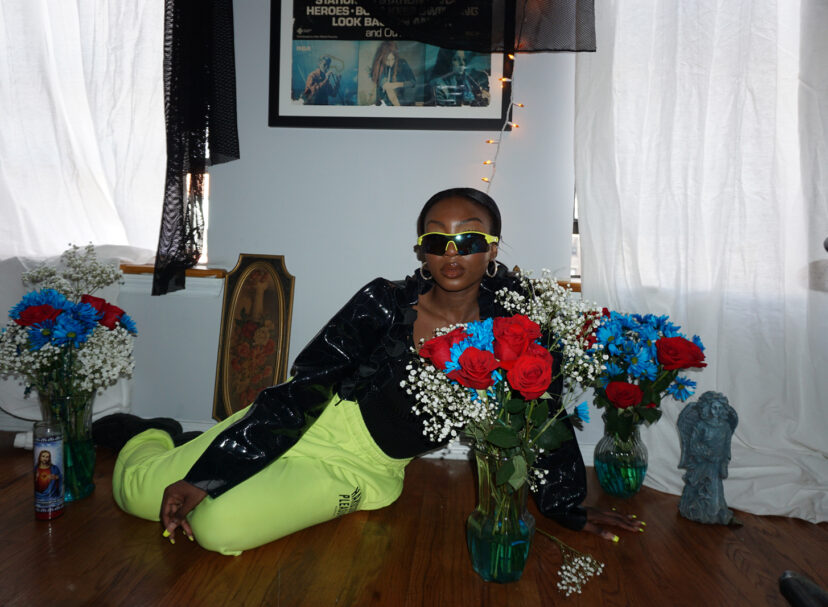Text: Alec Coiro
Photo: Olimpia Dior
A lot of people who are trying to rip you off pose a lot of questions without answering them. If you’re told it’s not about the answers but the journey, that’s probably a red flag. If the answer is inside yourself, ask for your money back.
This sort of charlatanism and wishwashery is not something you need to concern yourself with Rudiment, a clothing label by Ji Cartman, who knows exactly how she wants her clothing to serve the wearer. Much like the clothes she creates, nothing Cartman does is arbitrary; everything is in its place for a reason.
But I’m being abstract. Taking a look at the clothes themselves we can divine that the key to Rudiment is the way Cartman’s designs perfectly unravel the questions that she poses. The result is a well conceived, well tested, and soundly built structure. Often a neutral color, built to be worn in a variety situations and with utility in mind, the garments take their inspiration from clothing types that are often associated with uniforms: smocks, jumpsuits, coveralls, and the like. The clothes are designed to have their cuffs folded and sleeves rolled up, so they are as carefully fashioned on the inside as they are on the outside. Each garment must adapt to the varying needs of the wearer’s day, so it must be mutable and modular.

Why are Rudiment garments designed this way? Because a lot of thought went into them. On Cartman’s wall are Post Its queerying who it is she’s is designing for, and what this person’s characteristics are? And — to my delight — these are not an abstract questions. She has puzzled out the answers and created clothes to match the characteristics. It’s fascinating to hear her think through not just who she’s designing for but how the designs can best reflect that person. “I think she is confident, strong, curious. She knows what she wants. I thought about what that means. If she’s confident and down to earth that means she’s approachable. What does it mean for a garment to be approachable? And she’s strong. So I build up many layers for her. She’s curious, so she needs a tactile experience.” Each answer begets a new question which begets a new answer and the result is a process that is as layered and multifaceted at the clothing itself.
Not only do the designs reflect the characteristic of the person for whom she is creating, Cartman also feels it is important that the clothing fit this person’s particular needs. First, she conscious of what they might not need. “If I want a shirt, I can just go to J. Crew and get a shirt at a good price. So instead of making a conventional item. I want to do something different.” So if we don’t need another shirt or dress or pair of pants, what do we need? Cartman is very much a designer who inhabits her own clothing, wearing it exclusively and testing it out in the process, so in order to figure out what the Rudiment wearer needed, she thought about what she herself needed. She begins by noticing how much movement her day required, and how a certain amount of flow would help her clothing move with her. She also noticed how she moved through a day, embodying different roles and taking on different situations and needed a garment that could flow with her in that regard as well. “I realized that I moved a lot and my friends have days that require a lot of movement and require different types of clothes. I want to challenge the idea that there’s a time and a place for certain clothes. Garments that you can wear to drop off children, go to work, and go to dinner, and it’s still appropriate.”




I want to challenge the idea that there’s a time and a place for certain clothes.




Fashion is a second career for Cartman. What started as a sabbatical from her job as a creative director is now a full fledged operation with a studio in TriBeCa and a production team that can expand to as many as seven people when in the thick of it. Previously she created websites and apps for clients but yearned for a more tactile outlet, something with a material end product. “This is my second act. I used to do something totally different. I was an advertising director for an advertising agency. I never had a hobby. My work was my life. One day I thought maybe I should have a hobby, and do something outside of products that aren’t tangible.”
It’s easy to see how she brings the concept of user experience with her from her previous career. Artists and fashion designers often work by instinct (or at least so the stereotype goes); Cartman stands out as a designer who thinks not only about how the garment looks but also how it functions. Thus she not only wears her own clothes but acts as the “beta tester” as well. “I make my garment so what’s the point in not wearing it. I also like wearing it to test it out. I have a lot of layers and dangly stuff so I need to test what works and doesn’t work.” Coming from a world of updates, rolling releases, and constantly morphing web content, Cartman is always tinkering with her designs even after the season ends. This restless perfectionism is not about achieving the perfect fit — the individual garments are designed to fit a variety of sizes — it’s more a question of functionality. Are the sleeves easy to roll up? Can the cuffs be adjusted? The result is a garment that anticipates your needs. It’s a completely adaptable, almost modular garment that simultaneously manages to maintain a minimalists efficiency.
Much of what Cartman and I discussed was the mental aspect of the Rudiment design process. The soul of Rudiment is surely Cartman’s careful attention to fabrics. “I like fabric that reminds me of a really nice bed sheet: the ultimate comfort and intimacy. Something that’s your and yours only.”
I feel the fabric, and she’s not joking. It’s a specially processed cotton that instantly brings the phrase “curl up” to the mind. Cartman has put in the work to create a garment for every part of your day, and if it’s a long one, when it’s over, you can even curl up and go sleep in your Rudiment if you need to.






